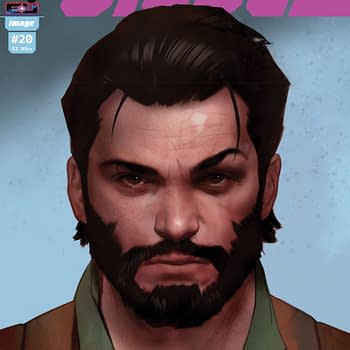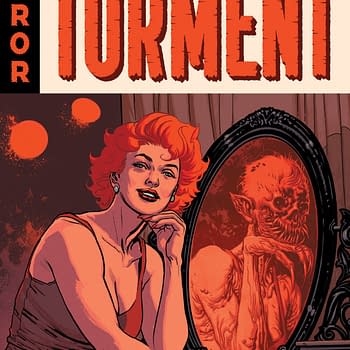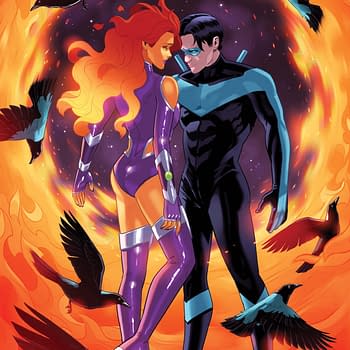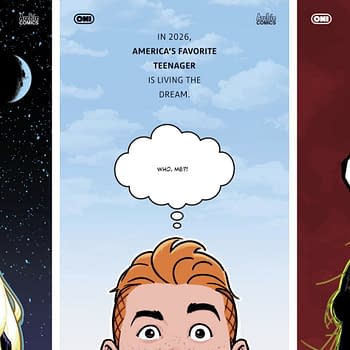Posted in: Comics, Recent Updates | Tagged: dreamwave, pat lee, Rich Johnston
Pat Lee Talks To Bleeding Cool Via A Dabel Brother

Except this was David Dabel of Sea Lion Press, one of the founders of Roaring Studios and then DB Pro with his brothers. Who haven't the greatest reputation when it came to paying people and the like. So what did he want to offer me? An interview with the rest of the Dabels? An appeal as to why he's not as bad at business as the rest of them? No. He wanted to offer me an interview with Pat Lee.
I'm stunned and amazed but it seems to check out. For context, a few years ago, a week wouldn't go by without me listing the latest crime against against comics by Pat Lee. Accusations of siphoning off money to leave creators in debt when bankruptcy came, lying to companies about creators working on his artwork, spending proflitagly while his unpaid creators starved, there was nothing the man could do right. And I mocked him as the same time. I laughed at his poetry that painted him a hypocrite, I posted a photo of his Porsche, and I registered a URL that he'd let slip to point at a summary of these allegations.
And now Pat Lee wants an interview with me? It's like George W Bush going on the Daily Show – no, going on the Michael Moore Show!
Well, I'm not going to say no, am I? I first shared with Pat a recent experience.
Rich Johnston: Pat, last Thursday I was in the pub with Simon Furman, currently working successfully in animation. Owed betwen $16,000 and $18,000 by Dreamwave, he told me that a month before the bankruptcy announcement, you were encouraging him to produce more work even though he was behind in payment, and that everything was fine with the company. A number of other creators back this account. He believes, as do they, that you knew the bankruptcy was coming, and were deceiving him. Were you?
Pat Lee: It was a very difficult decision to close Dreamwave. It was like my child; a studio starting from nothing and growing into something pretty significant. Thing is, when we started it, I was barely into my twenties, and didn't have enough business experience to properly manage it. By mid 2004, the company was facing some really trying financial issues.
The biggest problem was the downturn in sales. Transformers really launched us, and we were riding high with confidence. Everyone worked so hard on other titles, but many of the new projects underperformed. We ended up canceling or cutting titles without completing them. By that time, we had already built a pretty big organization and we were starting to struggle with overheads and expenses. The weakening US dollar also hurt. We had created some great work and presentations, but we also worried that our partners would not extend our agreements. We fought and fought to keep the company alive, and did everything we could (I stand by this 110%), but eventually my brother Roger and I saw that we couldn't win.
We did advise many contractors that we were having financial difficulties. I am not fully aware of all the conversations between employees and artists, but most people involved knew there was a tough situation going on. Many artists had delays in payment. I spoke to a lot of them about it, but I regret not being able to speak to everyone. There were so many fires to fight. Maybe we were over-confident. We definitely lacked experience. We thought we might still be able to pull through and keep Dreamwave and everyone who had worked so hard to help build it.
Rich Johnston: Pat, Simon Furman, the man who wrote Transformers, tells me that a month before the bankruptcy announcements, you were enthusiastic with him, even though he hadn't been paid, assuring him that everything was rosy and asking him for more work. That was a conversation between you and him, not anyone else. And other creators agree with this assessment that you, personally, were assuring freelance creators that everything was fine, despite late payments, without any indication of tough times. The accusation is not that you weren't talking to creators, but that you were lying to them.Pat Lee: I am unable to account for everyone but as far as I know, most creators at Dreamwave were aware that we were going through financial difficulties. We didn't announce it, but people were not being paid in full, and it was pretty obvious. When things got really tough, I tried to keep the team and myself motivated and push on with production. I had a wonderful experience creating and working with Simon, and I think we had a good relationship.. I did my best to let the creative team know what was going on, but everyone is entitled to his or her opinion on what transpired. I respect that.
Rich Johnston: The central allegation regarding the Dreamwave bankruptcy was that you and Roger engineered it to rid yourself of debts. That you planned for bankruptcy, diverted income months before the bankruptcy made for Dreamwave work to your new company Dream Engine. This not only hastened the bankruptcy of Dreamwave, but also meant there was less money to pay your debtors. Also, that turned a loan from your parents into a secured loan a year before bankruptcy (loans take a year to secure), so that any money left in the company could be secured for your family before anyoone else got a dollar. Also, that you made sure you kept your company owned Porsche, and paid half a million dollars for a new penthouse apartment, while some people lost their houses. How do you plead?Pat Lee: The Porsche was a leased vehicle and I was personally responsible for it. I returned it to the dealer a long time ago. And the "million dollar home" people say I bought in 2002 — that was a small apartment in Toronto that I paid a mortgage on – like everyone else. I barely paid myself at Dreamwave, and didn't pay myself for extended periods so that the company could pay other bills. I know a lot of people don't believe this, but it is what happened.
Rich Johnston: In that case why was the dealer listed as a secured creditor on the Dreamwave bankruptcy papers?
Pat Lee: The Porsche was leased by Dreamwave and I was personally responsible for the vehicle at the end. It was a burden to carry. Near the closing of Dreamwave I did not enjoy it one bit. Dream Engine Inc. (Canada) ceased operations in 2006 when all the partners split up. It was started when Dreamwave was still a viable business, and was not created to hide money. Its main purpose was to develop and hold new intellectual properties. Dreamwave's purpose was to publish comic books. Dream Engine Inc. (Canada) barely made any money, and it didn't grow strong enough legs at that time to go anywhere since we were so focused on keeping Dreamwave afloat. I am no longer associated with Dream Engine Inc.
Rich Johnston: Marvel have told me they were asked to stop paying money to Dreamwave but send it to Dream Engine instead, months well before the bankruptcy and, it seems, before that meeting between you and Simon Furman. Why do you believe Marvel would say that?
(No response from Pat to this interjection)
Pat Lee: About the loan I received from my family. At the time, we had pretty much maxed out our bank loans. Our parents were a last resort. We used the funds to pay artists, employees and some went to printers. We tried to cover as many of our staff as we could, but it was $100k, and it was gone in three months. Like I said, we were new to business management and we didn't plan for a sudden downturn in revenues. Both Roger and I are scarred from the whole ordeal, and we are very different people now. It was awful watching our own business crumble, and it was awful not being able to pay all the artists and staff who had worked so hard. But bankruptcy is just that. Unfortunately, no one gets out whole. Despite what people think, Roger and I were pretty much wiped out.
Rich Johnston: The reason people think differently is that you were seen to siphon money from big gigs away from Dreamwave to Dream Engine in the months before the bankruptcy. Which means that when Dreamwave went bankrupt there was less to be allocated to your debtors. Can you offer any evidence that this was not the case?
(No response from Pat to this interjection)
Pat Lee: Years have gone by now and I have spent quite a lot of time pondering how to help those artists get some of their money back. I've started a project with Sea Lion Publishing called "Creative Refund Movement" (CRM), the purpose of which is to raise funds to pay former Dreamwave artists who were financially affected by the bankruptcy. I understand that this is not an easy task, but I'm definitely up to the challenge. Of course, much is dependent upon sales and there are no guarantees, but we're going to give it a shot and we have some interesting projects that will help CRM. Dreamwave had its highs and lows, like every business. I still cherish the highs. The bankruptcy was a nightmare, but also taught me invaluable lessons.
Rich Johnston: You used a number of uncredited ghost artists at both Dreamwave and Dream Engine, such as Sigmund Torre and Nick Kilislian, but Top Cow told me that you assured them that you were personally creating every page for later issues of Cyberforce. When they discovered this was not true, that Alex Milne in some cases was drawing 95% of each page, you chose not to pay Milne at all for his completed work for you. Why?
Pat Lee: Alex did some work with Dream Engine Inc. several years before and was assisting me with layouts and some pencil backgrounds for Cyberforce. I was running late on my projects and asked him to help. He agreed and we brought him on board. I've worked on top of layouts from other artists and vice versa on many occasions even before Dreamwave, so I didn't think it was that big of a deal. Alex was really cool, and we got along very well for many years. Now I pencil all my work since I don't want people to get the wrong idea about me having a "Ghost Penciler".
With regard to his credit – I remember opening the book and noticing that he was not credited. I remember that I expressed in the to the Publisher who was working on the book from the beginning when we first signed on. But I forgot to adjust the credits at the end of the job. It was definitely my error and I apologize to Alex for this. If Alex claims that Dream Engine owed him money then he should provide me the appropriate documentation and evidence and we should try to sort it out. In my view, Alex is an excellent artist. I think we lost contact after he saw that he was overlooked in the credits.
Rich Johnston: Top Cow assure me that they specifically asked you if you were doing all the work supplied yourself and you told them you were. When I provided them with the evidence that Alex was drawing what seemed the majority of one of their books, they were shocked. Why do you believe Top Cow would feel that way?
(No response from Pat to this interjection)
Alex claims that you fired him and wouldn't return his emails when the true credits were revealed. Why do you think Alex would say this?
Pat Lee: I don't recall firing Alex. I expressed to him via email in May 2007 that I understood he was paid in full. I also expressed to Alex that DE had always tried to pay him promptly, which the company did. He was the first artist to get paid because frankly he was the best comic penciler on our roster at the time. I enjoyed working with Alex and I would have wanted to keep a relationship with him, not screw him over. He was my friend and there was no intention to let him go. Again, there are always going to be multiple perspectives based on each person's personal experience on the matter. As I mentioned previously, we should get in touch again so we can try to resolve any payment issues.
Rich Johnston: This Silver Snail exclusive variant cover for Dreamwave's Generation One (ongoing) issue 1 commissioned from you and credited to you. Who actually drew it?
Pat Lee: I can confirm that it is not my artwork and I'm not quite sure who contracted or agreed that I would illustrate it. I do not even recall that this art was done for the retailer. So, I'm a little confused myself. So much artwork was being produced at Dreamwave that I was unable to view every single piece going out the door, and couldn't monitor every discussion between employees and other partners, retailers and vendors.
I can look at my business experiences with Dreamwave and recall all the horrible moments but as I mentioned I learned a great deal from my past experiences and I'm really looking forward to getting the CRM moving. It's tough to look at a past battle that I lost because all I see is my negative experiences with the company.
There have been a lot of personal attacks and negativity directed at me. Some of it is perhaps justifiable, so I want to do something about it. Six years have gone by since the closing of Dreamwave. Not one day has gone by without my thinking about how I could have changed things. Now, I feel it would be better to look forward positively and do the best to reimburse former Dreamwave creatives. Sea Lion Publishing is a perfect match as they are very supportive of my vision.
Rich, thank you for this opportunity to speak openly about the subject (and) for your support in this endeavor. I hope that together we can look towards the future and make CRM as successful as possible.
Well, I don't know how successful that was. Pat wouldn't answer a number of specific questions. But I have to be intrigued by this attempt to pay back money owed – remember there was around a quarter of a million dollars, minimum. But I'm always willing to support such an approach, just in case it works out. And Bleeding Cool will be willing to report any and all such payments made.
2) .
> was a leased vehicle and I was personally responsible for it. I returned
> it to the dealer a long time ago.
In that case why was the dealer listed as a secured creditor on the
Dreamwave bankruptcy papers?
3.
> owed him money then he should provide me the appropriate documentation and
> evidence and we should try to sort it out. In my view, Alex is an excellent
> artist. I think we lost contact after he saw that he was overlooked in the
> credits.
Top Cow assure me that they specifically asked you if you were doing
all the work supplied yourself and you told them you were. When I
provided them with the evidence that Alex was drawing what seemed the
majority of one of their books, they were shocked. Why do you believe
Top Cow would feel that way?
Alex claims that you fired him and wouldn't return his emails when the
true credits were revealed. Why do you think Alex would say this?
4.
> split up. It was started when Dreamwave was still a viable business, and was
> not created to hide money. Its main purpose was to develop and hold new
> intellectual properties. Dreamwave's purpose was to publish comic books.
> Dream Engine Inc. (Canada) barely made any money, and it didn't grow strong
> enough legs at that time to go anywhere since we were so focused on keeping
> Dreamwave afloat. I am no longer associated with Dream Engine Inc.
Marvel have told me they were asked to stop paying money to Dreamwave
but send it to Dream Engine instead, months well before the bankruptcy
and, it seems, before that meeting between you and Simon Furman. Why
do you believe Marvel would say that?
http://milehighcomics.com/cgi-bin/backissue.cgi?action=fullsize&issue=98438430961%202
http://milehighcomics.com/cgi-bin/backissue.cgi?action=fullsize&issue=98438430961%203
> I were pretty much wiped out.
The reason people think differently is that you were seen to siphon
money from big gigs away from Dreamwave to Dream Engine in the months
before the bankruptcy. Which means that when Dreamwave went bankrupt
there was less to be allocated to your debtors.
Can you offer any evidence that this was not the case?
















